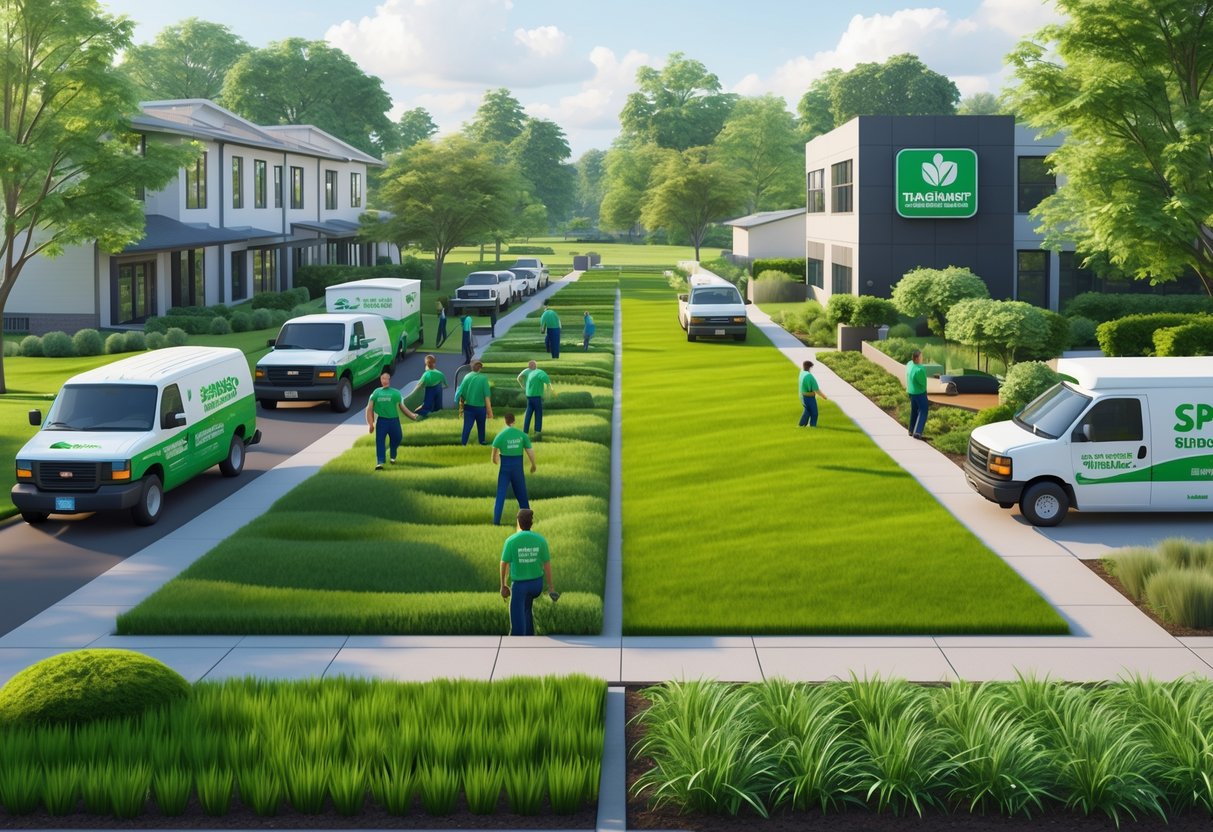Grassroots vs Franchising: Choosing the Best Path for Your Business
Updated On: October 23, 2025 by Aaron Connolly
Understanding Grassroots and Franchising Models
When you start building an esports business, you really only have two big options. You can go the grassroots route and build everything yourself from the ground up, or you can join an existing franchise system.
Grassroots businesses let you call all the shots creatively, but you’ll need to handle every single detail on your own. Franchising, on the other hand, hands you a blueprint and a recognizable brand, but you have to play by their rules.
Definition of Grassroots Businesses
Grassroots businesses start with nothing but your own ideas and effort. You create the brand, set up systems, and make every decision.
In esports, this could mean starting your own tournament organization, launching a streaming platform, or opening a gaming café—without following anyone else’s template. You get to figure out how you want to serve the gaming community.
Key characteristics of grassroots businesses:
- Total creative freedom
- No ongoing fees to any parent company
- You keep all profits
- Every decision falls on your shoulders
- The risk is higher, but so are the possible rewards
Plenty of successful esports organizations started small, sometimes in bedrooms or tiny venues. They built their names by hosting solid events and connecting with the community.
The tough part? You need to learn everything as you go. Legal stuff, marketing, even daily operations—no one hands you a playbook.
What Is Franchising?
Franchising means you run your business using someone else’s brand and systems. The franchisor gives you their recipe for success.
In esports, you’ll find franchise options for gaming cafés, training academies, and tournament organizers.
Core elements of franchising:
- Brand recognition – people already know the name
- Training programmes – you get to learn from those who’ve already made it work
- Ongoing support – help’s available when you hit a snag
- Marketing materials – you get ready-made advertising
You pay an initial fee and regular royalties to the franchisor. In return, you get their systems and their reputation.
The franchisor checks in to make sure every location stays up to standard. Customers should get the same experience, no matter which franchise they visit.
Key Differences Between the Two Models
Your choice between grassroots and franchising shapes everything about how you’ll run your business.
Investment and Financial Structure:
- Grassroots needs less money up front, but you can’t always predict future costs.
- Franchising costs more at the start, but the expenses are more predictable.
Control and Decision-Making: Grassroots means you’re in charge. You set prices, pick services, and decide how things look.
Franchises come with rules. The franchisor decides a lot—sometimes even down to the décor or which suppliers you use.
Risk and Support: Going grassroots is risky since you’re on your own, but you get all the rewards if it works. You only have yourself to rely on.
Franchising lowers risk with systems and support, but your success depends partly on how well the franchisor does.
Growth Potential: Grassroots lets you change direction fast and chase any opportunity. No franchise agreement holds you back.
Franchises can help you grow quickly at first, but the rules might limit your options down the line.
The Franchise Structure Explained

Franchises work by connecting a parent company with individual business owners. This setup creates a clear system for growing a business, with everyone knowing their responsibilities and following the same rules.
Role of the Franchisor
The franchisor acts as the parent company that owns the brand and the business model. You’ll see franchisors take on a lot of the heavy lifting to make the system work.
Brand Development and Protection
Franchisors build and maintain the brand. They handle marketing materials, logos, and ad campaigns. They also protect trademarks and make sure every location represents the brand the same way.
Training and Support Systems
Most franchisors run training programmes for new franchisees. They offer ongoing support—maybe through field reps or help desks. You’ll get help with operations, marketing, and troubleshooting.
System Standards and Quality Control
Franchisors write the rulebook that everyone follows. They show up for inspections and audits to keep quality high. They also set up supplier deals and negotiate bulk discounts.
Revenue Generation
Franchisors make money from franchise fees and royalties. These payments cover things like system-wide marketing, R&D, and support.
Role of the Franchisee
The franchisee runs the local business and follows the franchisor’s systems. The best franchisees know how to balance independence with sticking to the rules.
Daily Operations Management
Franchisees do the day-to-day stuff—hiring, customer service, local marketing. They keep inventory in check, look after the premises, and make sure they’re following the franchisor’s requirements.
Financial Responsibilities
Franchisees put in their own money to get started. They pay ongoing fees—usually royalties (around 4-8% of sales) and marketing contributions. They also cover operating costs and taxes.
Local Market Development
Franchisees usually know the local scene better than the franchisor. They tweak approved marketing to fit local tastes and build relationships in the community.
Compliance and Reporting
Franchisees stick to the franchise system exactly as it’s written. They send in regular sales and financial reports. They also join in on required training and updates.
Franchise Business Systems
The franchise system ties everything together for both franchisors and franchisees. You can think of these systems as the backbone of any solid franchise.
Standardised Operating Procedures
Franchise systems come with detailed manuals. These cover everything—how to prepare food, what to say to customers, you name it. This way, customers get the same experience everywhere.
Technology and Support Infrastructure
Modern franchises depend on tech. You’ll use the same point-of-sale systems, inventory software, and communication tools as everyone else in the network.
Marketing and Advertising Coordination
Franchises coordinate marketing at the national and local level. Franchisees chip in to a big advertising fund. Any local marketing needs approval to keep the brand consistent.
Supply Chain Management
Most franchises set up approved supplier networks. Franchisees buy stuff through these channels, which keeps quality steady and usually saves money with bulk deals.
Launching a Grassroots Business
Starting from scratch gives you all the control over your business’s vision and direction. The catch? You’ll have to handle everything—funding, building trust, and getting noticed—without the boost of a known brand.
Starting Your Own Business
When you launch a grassroots business, you’re the one building every piece from scratch. You create your brand identity, set prices, and make your own systems—no outside framework to lean on.
Complete creative freedom is the real perk. You pick your services, choose your market, and decide how your brand feels. A lot of entrepreneurs love that blank-canvas feeling.
But all the responsibility lands on you. You’ll run marketing, handle logistics, hire people, and make sure you’re following the law. No safety net here.
Quick win: Try testing your business idea with real customers before you spend big on infrastructure.
Your experience and industry know-how play a huge role in whether you succeed. Many first-time owners don’t realize how long it takes to build the basics that franchises hand you from day one.
Crafting a Unique Business Idea
Coming up with a unique business concept takes real market research and an understanding of what people actually need. Your idea has to solve a real problem or fill a gap.
Innovation opportunities are everywhere when you start from scratch. You can invent new services or mix old ones in fresh ways. This flexibility lets you react quickly if the market shifts.
Still, untested ideas are risky. If nobody wants what you’re building, you could waste months (and money) on something that flops. Testing the market before you commit is a must.
Think about:
- Gaps in your local market
- Your own skills and background
- How much it’ll cost to get started and how long until you might make money
- Who else is out there and how hard it is to break in
Warning: Don’t get too attached to your idea before you know people will pay for it.
Dig deep into your audience’s needs. Figure out what bothers them, what they spend on, and what they wish existed. Too many grassroots businesses fail because they fix problems nobody actually has.
Funding and Investment Challenges
Getting money for a grassroots business is usually harder than for a franchise. Banks and investors see new, unproven businesses as risky.
Self-funding is what most people end up doing. That can mean using savings, credit cards, or borrowing from family. Starting up usually takes anywhere from £10,000 to £50,000, depending on what you’re doing.
Banks want business plans, financial forecasts, and collateral. If you don’t have a franchise’s track record, it’s tough to get approved.
Other funding options:
- Crowdfunding sites
- Government small business grants
- Angel investors looking for fresh ideas
- Startup incubators or accelerators
Hidden costs sneak up fast. You’ll need money for mistakes, building systems, and bringing in customers slower than you hoped.
Grassroots funding takes time. It’s normal to spend 6–12 months raising enough, while franchisees might get loans faster since lenders know the model.
Initial Investment and Financial Requirements

If you start an esports organization from scratch, you’ll probably spend less up front but face surprise costs later. Franchising costs more at the beginning, but you know what you’re getting into.
Start-Up Costs for Grassroots Businesses
When you build an esports organization from nothing, you control where the money goes. You can start small with basic gear and ramp up as you grow.
Essential grassroots costs:
- Gaming gear and PCs: £2,000–£15,000 per player
- Rent for practice space: £500–£3,000 per month
- Marketing and branding: £1,000–£10,000
- Legal fees and contracts: £2,000–£5,000
A lot of grassroots teams start with players using their own stuff, so you might get by with under £10,000 at first.
But watch out for hidden costs:
- Paying players and staff
- Travel for tournaments
- Coaches’ salaries
- Upgrading or fixing equipment
Costs can swing wildly. You might spend £50,000 your first year—or £200,000. There’s no guarantee you’ll see a return.
Franchise Fees and Ongoing Royalties
Esports franchises stick to traditional business models with clear payments. You pay for the brand, the systems, and the network.
Typical franchise investment breakdown:
- Franchise fee: £25,000–£500,000 (one-off)
- Setup: £100,000–£2 million
- Royalties: 4%–20% of gross revenue
- Marketing fees: 2%–4% of revenue
Big-name esports franchises (think League of Legends slots) can cost millions. Smaller regional franchises might start at £100,000.
They’ll want:
- Enough liquid cash (often 40% of the total)
- Good credit
- A certain net worth
- Cash reserves for running the business
The upside is you know what you’re spending, and the model is proven. Financial planning gets a lot simpler compared to building from scratch.
Training and Support Systems
Franchisees get structured training and ongoing support from the franchisor. If you’re building a grassroots esports organization, you’ll mostly rely on learning as you go and maybe some help from peers.
Franchisee Training Programmes
Franchisees dive into comprehensive initial training that covers operations, marketing, and brand standards. Training usually lasts a few weeks or sometimes even months.
Most franchisors hand out operations manuals that lay out every part of running the business. These manuals break down daily tasks into step-by-step guides.
Franchisees often sit through classroom sessions and hands-on workshops. Many franchisors set up dedicated training centres, so new owners can get a feel for the business model in real life.
Ongoing education keeps franchisees in the loop about new products and industry changes. Monthly webinars and annual conferences seem pretty standard.
The franchisor brings in business coaches to help franchisees with challenges. These coaches check in regularly and review performance.
Benefits of franchise training:
- Proven business methods
- Shorter learning curve
- Consistent brand experience
- Access to expert knowledge
Grassroots Self-Learning and Mentorship
Grassroots esports organisations pick up knowledge by trying things out and learning from mistakes. Founders usually spend hours researching online and reaching out to other community leaders.
Self-directed learning often means digging into industry reports or binge-watching educational videos. Lots of grassroots leaders join Discord servers and Reddit threads, swapping stories and advice.
Grassroots organisations lean on peer mentorship. Experienced tournament organisers often step up and guide newcomers through their first events.
Local esports communities build informal support networks. These groups often share gear and even volunteer staff between events.
Quick win: Jump into esports organiser groups on social media. You’ll find experienced mentors in your area.
Grassroots learning methods:
- Online tutorials and guides
- Peer-to-peer knowledge sharing
- Learning from mistakes
- Community forums and Discord servers
Learning takes longer this way, but it leaves more room for creativity and local flavour.
Marketing and Brand Recognition
Franchise businesses start off with built-in brand awareness, giving owners a big head start. Grassroots ventures have to build their reputation from the ground up, which takes more time and money.
Franchise Marketing Benefits
Immediate Brand Trust
Buying into a franchise hands you an established brand name right away. Customers already know what your business is about.
McDonald’s franchisees never need to explain their menu. The golden arches have decades of marketing behind them.
Built-in Marketing Systems
Franchises share marketing materials and campaigns that already work. You get ready-made adverts, social media templates, and promotional strategies.
Franchisors often run national ads that help everyone. Local franchisees chip in for marketing but get exposure they’d never afford on their own.
Digital Marketing Support
Franchise systems usually include:
- Professional websites with local pages
- SEO tools
- Social media management
- Online ordering systems
Training and Guidelines
Franchisors walk you through their marketing playbook. You learn what works, no guesswork needed.
Brand guidelines keep things consistent everywhere. That’s how customers start to trust and recognise your business.
Challenges in Grassroots Marketing
Building Recognition from Zero
Independent businesses start with no brand awareness at all. Every single customer interaction is a chance to make your mark.
This takes months—sometimes years—of steady effort. You earn your reputation through good service and word-of-mouth.
Limited Marketing Budgets
Small businesses usually watch their marketing spend closely. Competing with franchise-level ad budgets? Not happening.
Common grassroots marketing struggles:
- Making professional marketing materials
- Running social media accounts
- Gathering online reviews and ratings
- Standing out against big brands
Learning Through Trial and Error
Without franchise support, you have to figure out marketing for yourself. That means trying different things and learning the hard way.
Many grassroots owners burn money on ads that just don’t work before they find their sweet spot.
Local Market Education
You need to explain what your business does and why it’s special. That takes more detailed marketing than an established brand needs.
Control, Autonomy, and Innovation

Grassroots business owners get full freedom over decisions, while franchise operators balance their own ideas with brand rules. Both paths lead to innovation, but they go about it in totally different ways.
Decision-Making in Grassroots Businesses
Grassroots owners call every shot. You set prices, pick suppliers, and design marketing campaigns without needing approval.
This freedom lets you move fast if the market shifts. If a new trend pops up locally, you can jump on it right away. Some grassroots businesses thrive by catching opportunities bigger brands overlook.
Key advantages include:
- Total control over branding and messaging
- Freedom to try new products or services
- Ability to personalise customer experiences
- No limits on operational changes
But freedom brings risk. Without a proven system, you could make mistakes that franchisees avoid thanks to established guidelines.
Innovation in grassroots businesses just kind of happens. You experiment, listen to customer feedback, and adapt to local needs. Some ideas work out, others flop, but every try teaches you something about your market.
Operating Within Franchise Guidelines
Franchise operators follow set systems that limit some choices but offer proven frameworks for success. The franchisor controls core brand elements like logos, product recipes, and service standards.
Most franchises draw a line between non-negotiable rules and things you can tweak. Core standards usually cover safety and brand consistency. You might have room to adjust local marketing or community involvement strategies.
Typical franchise control areas:
| Strict Control | Limited Flexibility | High Flexibility |
|---|---|---|
| Logo usage | Store layout | Local marketing |
| Product recipes | Employee uniforms | Community events |
| Safety protocols | Service timing | Staffing levels |
Innovation in franchises often starts with operators who find a better way locally. If something works, the franchisor may share it system-wide.
Many franchisors now use tiered autonomy. New operators follow strict rules at first, but earn more freedom as they prove themselves. Top-performing franchisees often get extra decision-making power in certain areas.
This structure keeps the brand consistent, but still allows for local tweaks and innovation.
Business Growth and Expansion Potential

Franchises scale up fast with outside investment and resources. Grassroots expansion moves at your own pace and lets you guard your brand standards. Both routes have upsides for building competitive gaming businesses.
Scalability of Franchises
Franchising ramps up growth by using other people’s money and local market knowledge. Franchisees put in their own cash to open new spots, so the original owner doesn’t need to front all the money.
This works well for gaming cafés and esports training centres. You can expand into new cities without huge upfront costs.
Key scaling advantages include:
- Faster market penetration
- Lower capital needs
- Local franchisee expertise
- Shared risks
But keeping quality high across all franchises takes strong training. Some franchisees might see the brand rules differently, which can mess with the customer experience.
Revenue usually comes from:
- Initial franchise fees (£15,000-£50,000)
- Ongoing royalties (5-8% of revenue)
- Equipment and supply sales
The tricky part is picking franchisees who really get gaming culture and standards.
Grassroots Expansion Strategies
Growing organically means you control every step of expansion. It takes more money upfront, but you keep your brand and operations tight.
Grassroots expansion usually means:
- Opening company-owned locations
- Growing one market at a time
- Reinvesting profits directly
- Managing everything centrally
This style works for premium esports facilities where you want top-notch equipment and expert coaching. You can make sure every location meets your standards.
Financial needs are bigger:
- Full setup costs (£100,000-£300,000 per spot)
- Ongoing expenses
- Hiring and training staff
- Marketing and promotion
Growth moves slower but stays predictable. You can test new ideas in one place before rolling them out. That cuts down on expensive mistakes across locations.
A lot of successful esports groups start grassroots, build a name, then maybe look at franchising later.
Case Study: Spring Green Franchise vs GrassRoots Turf

Spring Green asks for higher financial qualifications and targets existing businesses. GrassRoots Turf helps new entrepreneurs get started with lower barriers. Both franchises cover lawn care, but GrassRoots also includes tree and shrub care—Spring Green doesn’t.
Franchise Requirements Comparison
You can spot the differences in financial requirements right away.
Spring Green Requirements:
- Initial investment: £66,000-£84,000
- Net worth: £128,000
- Liquid cash: £48,000
GrassRoots Turf Requirements:
- Initial investment: £81,000-£121,000
- Net worth: £40,000
- Liquid cash: £40,000
Spring Green positions itself as a side franchise. You need an existing business to add their services, which explains the higher net worth.
GrassRoots Turf goes for a different crowd—brand new entrepreneurs. Their lower financial requirements open the door for more people.
Both franchises offer financing. GrassRoots seems more focused on helping first-time business owners get started.
Range of Lawn Care Services
Both franchises offer the basics, but GrassRoots throws in a bit extra.
Spring Green Services:
- Lawn fertilising and weed control
- Multiple insect control options
- Irrigation system maintenance
- Overseeding and core aeration
- Disease and lime treatments
- Ornamental bed weed control
GrassRoots Turf Services:
- Everything Spring Green offers
- Tree and shrub care
- Plant health programmes
GrassRoots Turf adds tree and shrub care, which can bring in more customers and extra revenue. Some homeowners just want one company to handle all their outdoor work.
Spring Green sticks to traditional lawn care. They cover the essentials, but you might miss out on customers who want a full-service option.
Growth Trajectories
The way these franchises grow says a lot.
Spring Green started in 1977 and reached 152 locations by 2021. That’s a solid track record, but their growth has slowed—they added just 9 new spots recently.
GrassRoots Turf began franchising in 2019 and hit 20 locations by 2022. That’s fast. Their parent company pulls in £4.2 million a year.
Spring Green’s established network means fewer open territories. Most of the best markets already have a franchise, so new owners might find it tough to expand.
GrassRoots Turf is still growing and looking for new franchisees. They’re pushing into new markets, and there’s more room to grow across the UK.
GrassRoots puts their energy into steady growth, while Spring Green seems to focus on keeping their current operations running smoothly.
Choosing Between Grassroots and Franchising in Lawn Care

Starting a lawn care business really comes down to two choices: build from scratch or buy into a franchise. Franchises give you a proven system and support, while grassroots startups let you steer the ship but carry more risk.
Factors to Consider as an Entrepreneur
Financial requirements really aren’t the same for everyone. If you’re starting a grassroots business, you’ll probably need somewhere between £5,000 and £15,000 for equipment and a bit of marketing to get rolling. Franchises, on the other hand, ask for much more—think £25,000-£75,000 upfront, plus ongoing royalties that usually take 5-8% of your revenue.
Time to profitability can be all over the place. Independent businesses often spend 12-18 months just building up a reliable client base. Franchise owners, though, tend to break even faster—sometimes in just 6-12 months—thanks to brand recognition and built-in marketing support.
Control levels are a big deal. Grassroots entrepreneurs call all the shots—pricing, services, branding, you name it. Franchise owners follow corporate rules, but they do get the benefit of tried-and-tested systems.
Risk tolerance comes into play more than people expect. Independent startups face higher odds of failure—about half close within five years. Franchises usually survive longer, since they lean on proven models and steady support from the franchisor.
Evaluating the Proven Business Model
Franchise systems set up structured operations that take out a lot of the guesswork. You get established pricing, service routines, and ways to bring in customers that have already worked elsewhere. This skips most of the trial-and-error that grassroots businesses deal with.
Training programmes give you a crash course in lawn care, business basics, and customer service. Most franchisors run a week or two of training right at the start, then keep offering more as you go. If you’re independent, you have to learn by doing or pay for outside courses.
Brand recognition does a lot of heavy lifting. Established franchises usually start getting customer enquiries right away, while grassroots businesses have to hustle for months to build up local trust.
Supplier relationships help cut costs. Franchise owners tap into bulk deals for equipment and supplies that solo operators just can’t access. Over time, these savings can even balance out the franchise fees.
Community Impact and Local Engagement

Both grassroots organisations and franchises weave themselves into their communities, but they do it in their own ways. Grassroots groups focus on building personal relationships, while franchises tend to use their systems to make a bigger economic impact.
Job Creation and Economic Benefits
Grassroots organisations usually create a handful of jobs locally. You’ll find a gaming café with 3-5 part-timers, or tournament organisers hiring freelance casters and tech support for events.
These roles are often flexible—great for students or folks trying to break into esports. Local owners usually mentor their staff, which gives people valuable hands-on experience.
Franchise operations bring in a lot more jobs. A typical esports franchise might employ 15-25 people, covering everything from management to technical support, coaches, and front-of-house staff.
Franchises also boost the local economy in other ways. They buy equipment from nearby suppliers and team up with restaurants for event catering, which sends extra business through the community.
Key Employment Differences:
- Grassroots: 2-8 jobs per venue
- Franchises: 15-30 jobs per location
- Training: Grassroots offers informal mentoring; franchises provide structured programmes
Building Customer Relationships
Grassroots venues shine at building tight-knit gaming communities. Regulars get to know each other through weekly tournaments and casual sessions. Staff remember customers’ names—and even their favourite games.
These personal connections keep people coming back. Players show up for the social scene as much as the games.
Franchise locations build loyalty differently, using consistent service and pro-level programming. They run organised leagues, coaching, and events that draw a wide range of people. Their brand makes new customers feel at ease right away.
Franchises use customer relationship management systems to track what people like. This helps them personalise experiences, even as they stick to professional standards.
Both models create welcoming community spaces, but they meet different needs.
Frequently Asked Questions

People often ask how grassroots organisations stack up against franchises when it comes to community impact and business results. Here are some of the most common questions about funding, involvement, and long-term prospects.
What are the main differences between grassroots organisations and franchises?
Grassroots organisations start with the community and often rely on volunteers. They’re usually small and driven by people who care about a local cause.
Franchises use a tried-and-true business model from a parent company. They follow set rules and procedures that work in lots of places.
Control is the main difference. Grassroots groups make their own calls based on local needs. Franchise owners stick to the franchisor’s guidelines and brand.
Funding is another big contrast. Grassroots groups depend on donations, grants, and volunteer time. Franchises need an upfront investment and regular fees to the parent company.
How can grassroots movements benefit local communities compared to franchised operations?
Grassroots movements get local problems in a way outsiders just don’t. They come from the community and focus on what really matters to people there.
These organisations adapt fast when things change. They don’t have to wait for approval from a head office to try something new.
Since locals own the group, all the benefits stay right there. Money raised goes straight to the cause, not to corporate profits or franchise fees.
Grassroots groups also build community connections that last. Volunteers often stick around for years, bring in others, and create real networks.
What are the challenges faced by grassroots initiatives when competing with franchise models?
Money is the tough part. Franchises pull from corporate cash and slick marketing, which grassroots groups can’t match.
Brand recognition is another hurdle. Franchises have national ads and a trusted name, while local groups have to build that trust from scratch.
Grassroots organisations often lack professional resources. They might not have access to business know-how, legal help, or tech that franchises take for granted.
Growing beyond one area is hard without a corporate structure. Grassroots groups usually struggle to expand or keep quality up as they grow.
In what ways do franchising structures impact the development of grassroots movements?
Franchises sometimes crowd out grassroots groups by offering similar services with more resources. That makes it tough for community organisations to attract volunteers and donations.
A strong corporate presence can mean less community ownership. People may turn to franchise services instead of building their own solutions.
But, sometimes franchises spark grassroots action. Communities might organise when they don’t like corporate expansion or when standardised services don’t fit local needs.
Some grassroots movements end up copying franchise structures as they grow. They build templates and support systems so new chapters can pop up elsewhere.
How do grassroots campaigns sustain themselves financially in contrast to franchised entities?
Grassroots organisations lean on small donations from the community. They run fundraising events—bake sales, sponsored walks, even local concerts.
Grants from foundations or government programmes help too. Many groups spend a lot of time writing grant applications.
Volunteers keep costs down by working for free, so more money goes to programmes—not salaries.
Franchises work differently. Owners invest upfront and keep things running with sales. They pay franchise fees, but in return, they get a proven business model and marketing help.
What role does community involvement play in the success of grassroots versus franchised systems?
Community involvement really matters for grassroots groups. These organizations depend on local volunteers, donors, and champions if they want to stick around and grow.
People in the community help grassroots groups spot what’s actually needed. Locals shape decisions and make sure the programs actually make a difference.
Franchises, on the other hand, lean more on customers than on deep community ties. They usually focus on delivering a steady service that matches what the main company expects.
Still, some franchises do try to connect with the community. They might hire local folks or sponsor events. The best franchise owners pay attention to their area and tweak things a bit—just enough to fit in, while staying inside corporate rules.


